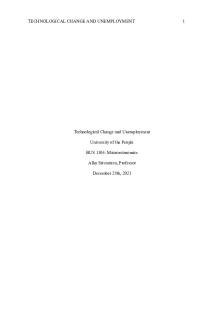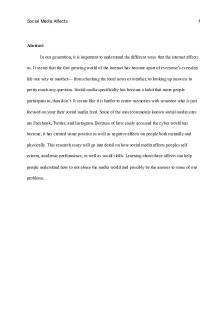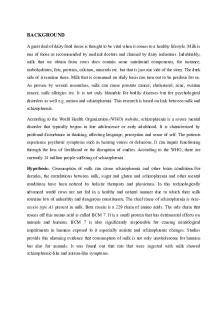Technological Change and Unemployment and its effects PDF

| Title | Technological Change and Unemployment and its effects |
|---|---|
| Course | Macroeconomics |
| Institution | University of the People |
| Pages | 5 |
| File Size | 79.6 KB |
| File Type | |
| Total Downloads | 64 |
| Total Views | 200 |
Summary
This document describes how technological change has affected unemployment in the world. If it had negative effects or positive effects....
Description
TECHNOLOGICAL CHANGE AND UNEMPLOYMENT
Technological Change and Unemployment University of the People BUS 1104: Macroeconomics Alka Srivastava, Professor December 28th, 2021
1
TECHNOLOGICAL CHANGE AND UNEMPLOYMENT
2
Technological Change and Unemployment The advancement of automation, facilitated by technology such as robotics and artificial intelligence, promises enhanced productivity (and economic growth), efficiency, safety, and simplicity. However, these innovations pose troubling questions about the more significant effects of automation on jobs, skills, pay, and the form of labour. A technological change can be described as a rise in the returns available with a particular amount of inputs through the phases of development, innovation, and dissemination (Popp,2010). Structural unemployment is a type of unemployment that lasts for a long time and is aggravated by external causes such as technology. Structural unemployment arises when workers lack the necessary job skills or reside too far away from job opportunities and cannot relocate. There are jobs available, but there is a significant misalignment between what employers require and what employees can provide (Rittenberg & Tregarthen, 2012). It is undeniable that technological advancements have lowered the demand for ordinary automated labour while increasing the demand for and pay for high-skilled technical and analytical labour (Saunders, n.d.). Machines have aided people in producing more yield throughout history. Despite fears that automation will eliminate jobs or result in mass unemployment, technology has always resulted in new ones. Indeed, as worker productivity increased, so did job growth in the past. Machine advancements enhanced efficiency and reduced production costs, establishing mass production. The consequent boom in economic expansion during this period enabled the development of consumerism, which resulted in creating more jobs (Saunders, n.d.). However, more people are losing jobs compared to getting new jobs. The jobs are for people with higher education. Therefore, technology has generally led to more unemployment. New digital technologies are becoming more widely adopted in the economy. As a
TECHNOLOGICAL CHANGE AND UNEMPLOYMENT
3
result of this automation, machines are becoming capable of performing tasks formerly only performed by humans. New products, services, and business models arise as manufacturing processes and organizations change ( Real Coleigo Compultense, n.d.). There will be increased production as machines are more efficient in the future. Humans can focus on dealing with consumers and marketing the products. Technology is widely acknowledged in economics as the primary driver of economic growth in countries, regions, and cities (Hausmann, n.d.). Technological advancement enables more efficient output of more and better goods and services, which is essential for success. We cannot deny that technological change leads to structural unemployment, which the economy can recover from. On the other hand, if technology leads to people losing jobs, the real GDP decreases hence slower economic growth. An economy can recover from structural unemployment by encouraging businesses and unemployed people to learn and update their skills. For example, if a firm has introduced new technology, they can develop their firm more in terms of marketing and supply of products and improve their customer service instead of laying off their employees upon the introduction of new technology. The firms can develop new production processes and educate their employees beforehand, and the economy can recover once the production goes to its average level and employment. The government can put in place policies for government training programmes for the structurally unemployed individuals, paying grants to firms that provide training to jobseekers, assisting the structurally unemployed in relocating to regions where jobs are available, and incentivizing aspiring individuals to resume their education. In conclusion, it is clear that technological change causes structural unemployment, but as the economy grows, a country can increase its production and catch up with the rest of the world. Structural unemployment eventually encourages people to develop themselves;
TECHNOLOGICAL CHANGE AND UNEMPLOYMENT hence governments and economists anticipate technology change. Word count: 589
References
4
TECHNOLOGICAL CHANGE AND UNEMPLOYMENT
5
Edgmand, M. (n.d.). Economics 504. https://www3.nd.edu/~cwilber/econ504/504book/outln12e.html Hausmann, R. (n.d.). Knowledge, technology and complexity in economic growth. Real Colegio Complutense. https://rcc.harvard.edu/knowledge-technology-andcomplexity-economic-growth Knowledge, technology and complexity in economic growth. Real Colegio Complutense. (n.d.). https://rcc.harvard.edu/knowledge-technology-andcomplexity-economic-growth Popp,D. (2010). Technological change. Technological Change - an overview | ScienceDirect Topics. https://www.sciencedirect.com/topics/economicseconometrics-and-finance/technological-change Rittenberg, L. and Tregarthen, T. (2012). Macroeconomics Principles V. 2.0. Licensed under Creative Commons by-nc-sa 3.0 (https://creativecommons.org/licenses/by-nc-sa/3.0/). Saunders, A. (n.d.). Technology's impact on growth and employment. OpenMind. https://www.bbvaopenmind.com/en/articles/technology-s-impact-on-growthand-employment/...
Similar Free PDFs

Oc spray and its effects
- 3 Pages
Popular Institutions
- Tinajero National High School - Annex
- Politeknik Caltex Riau
- Yokohama City University
- SGT University
- University of Al-Qadisiyah
- Divine Word College of Vigan
- Techniek College Rotterdam
- Universidade de Santiago
- Universiti Teknologi MARA Cawangan Johor Kampus Pasir Gudang
- Poltekkes Kemenkes Yogyakarta
- Baguio City National High School
- Colegio san marcos
- preparatoria uno
- Centro de Bachillerato Tecnológico Industrial y de Servicios No. 107
- Dalian Maritime University
- Quang Trung Secondary School
- Colegio Tecnológico en Informática
- Corporación Regional de Educación Superior
- Grupo CEDVA
- Dar Al Uloom University
- Centro de Estudios Preuniversitarios de la Universidad Nacional de Ingeniería
- 上智大学
- Aakash International School, Nuna Majara
- San Felipe Neri Catholic School
- Kang Chiao International School - New Taipei City
- Misamis Occidental National High School
- Institución Educativa Escuela Normal Juan Ladrilleros
- Kolehiyo ng Pantukan
- Batanes State College
- Instituto Continental
- Sekolah Menengah Kejuruan Kesehatan Kaltara (Tarakan)
- Colegio de La Inmaculada Concepcion - Cebu














